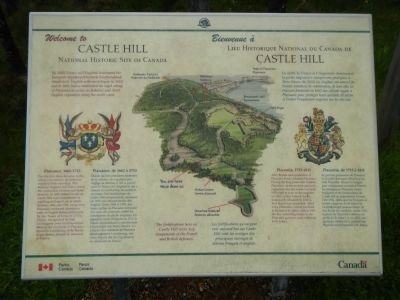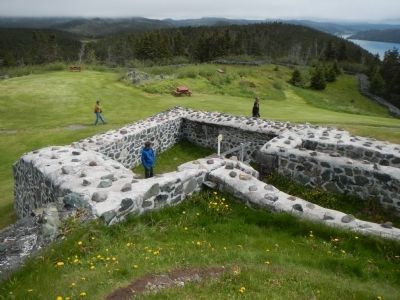Placentia in Avalon Peninsula, Newfoundland, Newfoundland and Labrador — The Atlantic Provinces (North America)
Castle Hill

Photographed By Barry Swackhamer, June 21, 2014
1. Castle Hill Marker
Caption (English / French): The fortifications here on Castle Hill were key components of the French and British defenses. / Les fortifications qu’on peut voir aujourd’hui sur Castle Hill sont les vestiges des principaux ouvrages de défense français et anglais.
Click image to enlarge it and see the site map.
Click image to enlarge it and see the site map.
Castle Hill
National Historic Site of Canada
By 1600, France and England dominated the European migratory fisheries to Newfoundland. Small-scale English settlements began in 1610, and in 1662 France established the royal colony of Plaisance to secure its fisheries and check English expansion along the south coast.
For the first three decades of the colony’s existence, its defences received little attention. War between England and France led to the construction of newer and better defences. In 1692, defence works on Castle Hill were instrumental in repelling an English naval attack. Between 1696 and 1709, forces from Plaisance conducted destructive raids on English fishing settlements. By the Treaty of Utrecht (1713), France recognized British sovereignty over Newfoundland. Most of the residents of Plaisance moved to Louisbourg on Ile Royale (Cape Breton Island) or returned to France.
After Britain took possession of Plaisance it was renamed Placentia. During the long peace after Utrecht, Placentia’s defences were generally neglected and the the works on Castle Hill went to ruin. In the summer of 1762, when French forces temporarily occupied St. John’s, Fort Royal was upgraded. After 1763, Placentia’s status declined in favor of St. John’s, and in 1811 the few remaining troops in the Placentia garrison were removed to St. John’s.
French
Lieu Historique National du Canada
Castle Hill
En 1600, la France et l’Angleterre dominaient la pêche migratoire européenne pratiquée a Terre-Neuve. En 1610, les Anglais ont amorcé de timides tentatives de colonisation; de leur côte, les Français fondaient en 1662 une colonie royale à Plaisance pour protéger leurs activités de pêche et limiter l’expansion anglaise sur la côte sud.
Durant les trois premières décennies de la colonie, on a quelque peu négligé sa défense. C’est la guerre entre la France et l’Angleterre qui a stimulé la construction de meilleurs ouvrages. Les fortifications de Castle Hill ont permis de repousser en 1692 une attaque navale de Anglais. Entre 1696 et 1709, des forces parties de Plaisance ont mené des raids dévastateurs contre les installations des pêche anglaises. En signant le traité d’Utrecht en 1713, la France reconnaissait la souveraineté britannique sur Terre-Neuve. La plupart des habitants de Plaisance déménagèrent à Louisbourg, sur l’Isle-Royale (île du Cap-Breton), ou rentrèrent en France.
En prenant possession de Plaisance, la Grande-Bretagne rebaptisait la ville Placentia. Durant la longue paix subséquente au traité d’Utrecht, les défenses de Placentia furent négligées et les fortifications de Castle Hill se dégradèrent. Durant l’été 1762, après que les Français se furent emparés de St. John’s et l’eurent occupé quelque temps le fort Royal fut amélioré. Après 1763, la place de Placentia s’atténua au profit de St. John’s et, en 1811, les quelques soldats de la garnison de Placentia furent rapatriés à St. John’s.
Erected by Parks Canada.
Topics. This historical marker is listed in this topic list: Forts and Castles. A significant historical year for this entry is 1600.
Location. 47° 15.086′ N, 53° 58.341′ W. Marker is in Placentia, Newfoundland and Labrador, in Avalon Peninsula, Newfoundland. Marker is on Castle Hill Road close to Route 100 South. Touch for map. Marker is in this post office area: Placentia NL A0B, Canada. Touch for directions.
Other nearby markers. At least 5 other markers are within walking distance of this marker. A different marker also named Castle Hill (a few steps from this marker); Fort Royal (Plaisance) (within shouting distance of this marker); Port Royal and Castle Graves (within shouting distance of this marker); (Fort Royal) (about 90 meters away, measured in a direct line); Fort Frederick (approx. 0.8 kilometers away).
More about this marker. This marker is located opposite the Castle Hill Visitors Center at the end of Castle Hill Road.
Also see . . . Fort Royal (Plaisance). In 1662, the French established a commercial counter on a well protected hill overlooking Placentia Bay which separates the Avalon form the rest of Newfoundland island and situated near Grand Banks where fish are abundant. (Submitted on November 15, 2014, by Barry Swackhamer of Brentwood, California.)
Credits. This page was last revised on June 16, 2016. It was originally submitted on November 15, 2014, by Barry Swackhamer of Brentwood, California. This page has been viewed 374 times since then and 16 times this year. Photos: 1, 2. submitted on November 15, 2014, by Barry Swackhamer of Brentwood, California. • Andrew Ruppenstein was the editor who published this page.
